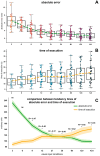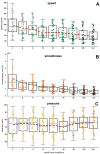The Role of Visual Information Quantity in Fine Motor Performance
- PMID: 39728251
- PMCID: PMC11676225
- DOI: 10.3390/jfmk9040267
The Role of Visual Information Quantity in Fine Motor Performance
Abstract
Background/objectives: Fine motor movements are essential for daily activities, such as handwriting, and rely heavily on visual information to enhance motor complexity and minimize errors. Tracing tasks provide an ecological method for studying these movements and investigating sensorimotor processes. To date, our understanding of the influence of different quantities of visual information on fine motor control remains incomplete. Our study examined how variations in the amount of visual feedback affect motor performance during handwriting tasks using a graphic pen tablet projecting on a monitor.
Methods: Thirty-seven right-handed young adults (20 to 35 years) performed dot-to-dot triangle tracing tasks under nine experimental conditions with varying quantities of visual cues. The conditions and triangle shape rotations were randomized to avoid motor training or learning effects. Motor performance metrics, including absolute error, time of execution, speed, smoothness, and pressure, were analyzed.
Results: As visual information increased, absolute error (from 6.64 mm to 2.82 mm), speed (from 99.28 mm/s to 57.19 mm/s), and smoothness (from 4.17 mm2/s6 to 0.80 mm2/s6) decreased, while time of execution increased (from 12.68 s to 20.85 s), reflecting a trade-off between accuracy and speed. Pressure remained constant across conditions (from 70.35 a.u. to 74.39). Spearman correlation analysis demonstrated a moderate to strong correlation between absolute error and time of execution across conditions. The Friedman test showed significant effects of experimental conditions on all motor performance metrics except for pressure, with Kendall's W values indicating a moderate to strong effect size.
Conclusion: These findings deepen our understanding of sensorimotor integration processes and could potentially have implications for optimizing motor skills acquisition and training and developing effective rehabilitation strategies.
Keywords: fine motor behavior; fine motor movements; graphic pen tablet; motor performance; sensorimotor integration; tracing task; visual feedback.
Conflict of interest statement
The authors declare no conflicts of interest.
Figures




Similar articles
-
Influence of age and movement complexity on kinematic hand movement parameters in childhood and adolescence.Int J Dev Neurosci. 2008 Nov;26(7):655-63. doi: 10.1016/j.ijdevneu.2008.07.015. Epub 2008 Aug 5. Int J Dev Neurosci. 2008. PMID: 18725285
-
Haptic Guidance to Support Handwriting for Children With Cognitive and Fine Motor Delays.IEEE Trans Haptics. 2021 Jul-Sep;14(3):626-634. doi: 10.1109/TOH.2021.3068786. Epub 2021 Sep 9. IEEE Trans Haptics. 2021. PMID: 33769937
-
Handwriting on a tablet screen: Role of visual and proprioceptive feedback in the control of movement by children and adults.Hum Mov Sci. 2019 Jun;65:S0167-9457(18)30093-9. doi: 10.1016/j.humov.2018.09.001. Epub 2018 Sep 12. Hum Mov Sci. 2019. PMID: 30219272
-
Psychological and Physiological Processes in Figure-Tracing Abilities Measured Using a Tablet Computer: A Study with 7 and 9 Years Old Children.Front Psychol. 2016 Oct 18;7:1528. doi: 10.3389/fpsyg.2016.01528. eCollection 2016. Front Psychol. 2016. PMID: 27803678 Free PMC article.
-
Integrated technology for evaluation of brain function and neural plasticity.Phys Med Rehabil Clin N Am. 2004 Feb;15(1):263-306. doi: 10.1016/s1047-9651(03)00124-4. Phys Med Rehabil Clin N Am. 2004. PMID: 15029909 Review.
References
-
- Józsa K., Oo T.Z., Borbélyová D., Zentai G. Exploring the Growth and Predictors of Fine Motor Skills in Young Children Aged 4–8 Years. Educ. Sci. 2023;13:939. doi: 10.3390/educsci13090939. - DOI
-
- Fauth E.B., Schaefer S.Y., Zarit S.H., Ernsth-Bravell M., Johansson B. Associations Between Fine Motor Performance in Activities of Daily Living and Cognitive Ability in a Nondemented Sample of Older Adults: Implications for Geriatric Physical Rehabilitation. J. Aging Health. 2017;29:1144–1159. doi: 10.1177/0898264316654674. - DOI - PMC - PubMed
LinkOut - more resources
Full Text Sources
Research Materials

